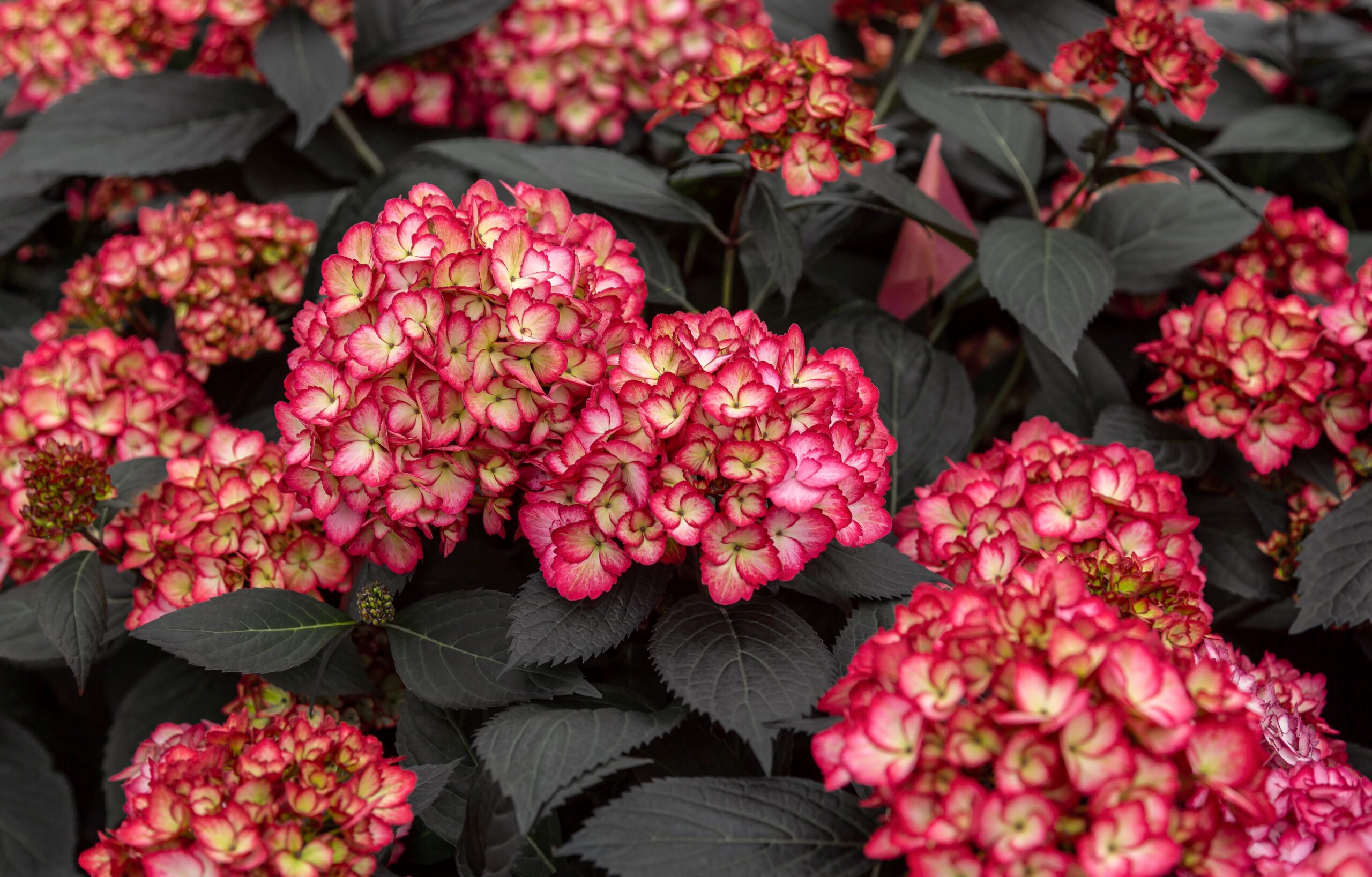These interesting new intros offer eye-catching dusky-hued leaves
We already love hydrangeas for their incomparable flowers, but there’s a new look in hydrangeas, and it’s in the foliage!
As designers know, foliage lasts much longer than fleeting flowers, so plant lovers take note when a favorite plant gets a new look, with variegated, gold, or — especially hot these days —gothy black leaves.
Check out these hydrangeas that dazzle with dark stems and leaves — and a new release that may be the darkest ever.
Breeding until now
Although dark leaves are cropping up in other genera, such as crepe myrtles (Lagostroemeia), “There haven’t been a ton of dark hydrangeas up until now,” said Peter Eastman, tree and shrub buyer for Al’s Garden & Home, Woodburn, Oregon.
A few rough-leaf hydrangeas (Hydrangea aspera), a lacecap species with dark leaves, have been garden favorites for many years.
Eastman likes longtime favorite ‘Preziosa,’ whose leaves turn purple, especially with greater sun exposure.
Dan Hinkley, plant explorer and owner of Windcliff Nursery in Washington, is known for hydrangea collecting. He recently called out H. aspera ‘Plum Passion,’ while discussing tough plants that survived an ice storm. Speaking at Seattle’s Northwest Flower and Garden show, he said if he could have just one hydrangea, he would pick ‘Plum Passion.’ ‘Plum Passion’ needs some elbow room, however – it can get up to 8’ x 8’.
Among newer introductions, Eastman calls ‘Tiny Tuff Stuff™’ a lacecap mountain hydrangea (H. serrata) cultivar “one of our best rebloomers” — and it’s a compact 2’ x 2’.
“One of the most popular is ‘Oregon Pride,’ bred right here in Oregon,” said Eastman. He calls the cultivar of H. macrophylla a strong grower whose dark red stems make the statement highlighting the burgundy-to-purple flower.
Favorite dark H. serratas for Kristin VanHoose, co-owner of Aurora-based mail-order nursery Hydrangeas Plus include ‘Kiyosumi,’ named for its Japanese mountain home, whose new burgundy growth greens in summer, going back to burgundy when temperatures cool off, and ‘Kurohime,’ offering “show-stopping” purple stems and rich colored leaf veins in spring and fall, morphing to bright apple green foliage in summer.
Eastman highlights a new bigleaf hydrangea (H. macrophylla) option, dwarf ‘Kimono, ’ whose mophead flowers are wine red with a white edge. The new growth comes in deep burgundy, adding variety to seasonal interest.
So far, we’ve had dark stems, or dark foliage that turned green in summer. Until now.
Billed as the blackest hydrangea ever, the reblooming ‘Eclipse’® hydrangea (H. macrophylla) just hit the market this year. It holds that luscious color all season, despite the weather, complementing “cranberry or amethyst” mophead flowers with a white eye. It was the belle of Seattle’s Northwest Flower and Garden Festival in February, seen in display gardens, the market, and in promotional materials complete with QR codes. Averaging about 4’ tall and wide, ‘Eclipse’ likes a morning sun exposure, and after its initial bloom, reblooms intermittently.
With ‘Eclipse®’, Eastman says its breeder Bailey Nursery has “hit the jackpot as far as deep dark purple foliage. I was given a plant in July,” he said, “and it stayed deep blackish purple until the leaves fell off. I think it’ll be a game changer that allows you to use hydrangea as a focal point just for foliage.”
The breeding process for ‘Eclipse®’ has taken several years. “The initial Eclipse® seedling was selected in 2016 and, after 8 years of testing to ensure that consistency in dark foliage, was introduced to the marketplace in 2024,” said Ryan McEnaney, marketing and communications manager for Bailey Nursery.
McEnaney gave these tips for care: “Because ‘Eclipse®’ blooms on the previous season’s growth and the new stems this season, don’t do any hard pruning. In late spring, only cut off what didn’t survive the winter, and then deadhead spent blooms in mid-summer. Well-drained soil that remains evenly moist, morning sun and dappled afternoon shade, and bloom-boosting fertilizer application in early spring and early summer will maximize blooms.”
Even the darkest leaves aren’t solid black, however. Like stained glass, they let shimmers of plum, burgundy, and dark green shine through to various degrees. Yet the combinations you can make with black-leafed hydrangeas in the garden are nearly endless. You can contrast with nearby gold, chartreuse, silver, blue, peach and green foliage, or complement with moody reds and burgundies. Like a little black dress, a black leaf goes with everything.

